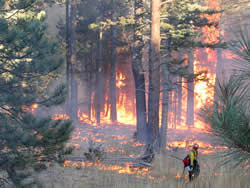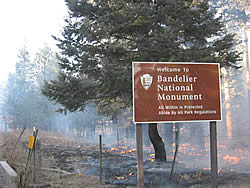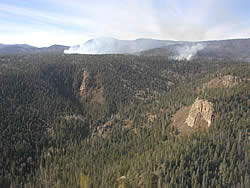
National Fire Plan Success Story
Bandelier's Fire Management Program Back on Track
Bandelier National Monument, New Mexico
National Fire Plan - Fuels Reduction

Upper Frijoles (Unit 9) Prescribed Fire NPS Photo, by Kevin Vogler, November 8, 2007.
Slow but sure best describes Bandelier National Monument's prescribed fire program since the 2000 Cerro Grande Fire. Last year 60 acres were treated during the Unit 40 Prescribed Fire. The November 2007 Upper Frijoles (Unit 9) Prescribed Fire treated approximately 1,500 acres - the park's first large scale burn in the past seven years.
In May 2000, a planned prescribed fire ignited by the Bandelier fire staff escaped containment and became the Cerro Grande Fire. This 40,000+ acre fire destroyed over 235 structures in and around Los Alamos, New Mexico (202 of which were primary residences) and damaged public and private lands on an unprecedented scale. The fallout from this escaped prescribed fire was one of the main factors that initiated the 2000 National Fire Plan which changed fire policy across the nation. It also temporarily grounded the prescribed fire program at Bandelier.

Upper Frijoles (Unit 9) Prescribed Fire. NPS Photo, by Sarah DeMay, November 8, 2007.
Since that incident, the entire staff at Bandelier has worked diligently to reestablish connections with local residents, including many who lost homes or property. One of the most important things they established was the educational and informational outreach programs that were instituted in the years following 2000. Public meetings, open houses, meetings with local organizations, media interviews, news releases, presentations and handouts were all instrumental in regaining the public's support after the Cerro Grande incident. The local public remains very supportive of the efforts by the fire management staff to revive and renew their prescribed fire program.
Bandelier has also worked very closely with their interagency partners in getting their prescribed fire program back on line. These partners include the Santa Fe National Forest, National Park Service, Bureau of Land Management, U.S. Fish and Wildlife Service, Bureau of Indian Affairs, the State of New Mexico, Los Alamos County, and Los Alamos National Laboratory. These agencies work together to identify, discuss and coordinate issues pertaining to wildfire mitigation and management in the Los Alamos area. The cooperation of these agencies is vital to the successful operation of all their fire programs, including Bandelier's.
The Upper Frijoles (Unit 9) Prescribed Fire had been planned for years, but was postponed several times due to unfavorable weather conditions. On November 7, 2007, after all of the preparations on the unit were complete and resources were in place, the Upper Frijoles (Unit 9) Prescribed Fire was finally ignited.
Since the Cerro Grande fire in 2000, everyone is asking us why we need to burn in Bandelier," said Bandelier National Monument Acting Superintendent Vito Spinale. "The answer is that we have a responsibility as a land management agency to reduce our fuels and provide buffers to our neighbors. We have too much fuel in many hard-to-reach canyons. We cannot let these canyons become pathways for wildfires to travel into surrounding communities. We know that this is an issue that must be addressed collaboratively and with the full support of the community."

Aerial View of Upper Frijoles (Unit 9) Prescribed Fire. NPS Photo, by David Eaker, November 9, 2007.
Many measures were taken to ensure the fire stayed within prescription. A 600-foot buffer was mechanically thinned along State Highway 4 and Forest Road 289. Fire lines were built around every section of the burn unit. More then 100 interagency firefighters, including 8 engines, 1 helicopter, 3 crews, and several water tenders were dedicated to the burn. Bandelier park staff from a variety of divisions including interpretation, visitor services, and maintenance provided invaluable assistance throughout the burn as well. Additional contingency resources were identified and available if needed. The colder temperatures at night and shorter days added an additional element of control.
The burn unit was divided up into small sections totaling approximately 1,500 acres. The project began with a hand ignited black-lining operation along the northern and eastern edges of the unit bordering State Highway 4 and Forest Road 289. This provided fire personnel with a buffer zone of burned fuel between the highway and the interior of the unit. Firefighters worked slowly and deliberately during this operation to make sure the fire did not cross the unit boundaries. Crews then began hand igniting the interior of the burn unit. A helicopter with a Plastic Sphere Dispenser Machine (PSD) was utilized for aerial ignition in areas of the burn unit with steep and dangerous terrain.
Public and firefighter safety was the priority throughout the burn. Traffic control along State Hwy 4 and Forest Road 289, provided by Law Enforcement Park Rangers from Bandelier and other nearby parks, played a vital role in ensuring safe operations. Rangers helped patrol the area, post temporary road signs warning travelers of possible smoke and delays ahead, provide flaggers, and manage one-lane traffic led by a pilot car when smoke impeded visibility along the road or when firefighters were working immediately along the roadside. Travel advisories were included in daily fire updates, news releases, the incident website, and on the message on the local 1610 AM emergency alert radio station.
Part of the success of the project involved the cooperation received from two private land owners whose land are surrounded by the monument. They both worked in conjunction with the fire and monument staff to ensure that all the necessary agreements had been made prior to ignition. One of the land owners did not want their property to have fire on it so mitigation were put in place to prevent it from occurring. The other landowner had already been doing fuel reduction treatments on their property in preparation of the prescribed fire. They agreed to allow fire personnel to burn debris piles on their property and then follow that up with a broadcast burn.
"I didn't want to clear the fuels on my property at first because I liked having the trees," said park in-holder Sam Gardner. "But after several wildfires burned through the area, I started thinning the fuels on my property. The next step for me was a burn like this. It would have been too much for me to take this on safely on my own. I'm so glad they could step in and help. Everyone who lives in the mountains needs to be responsible with their fuels, otherwise they're just sitting ducks," he added.
This successful completion of the Upper Frijoles (Unit 9) Prescribed Fire has helped get Bandelier's fire program back on track and will allow them to be able to carry on the policy of using fire as management tool to help perpetuate the resource values for which the monument was established.
Contact: Gary Kemp, Fire Management Officer, Phone: (505) 672-3861 x 550